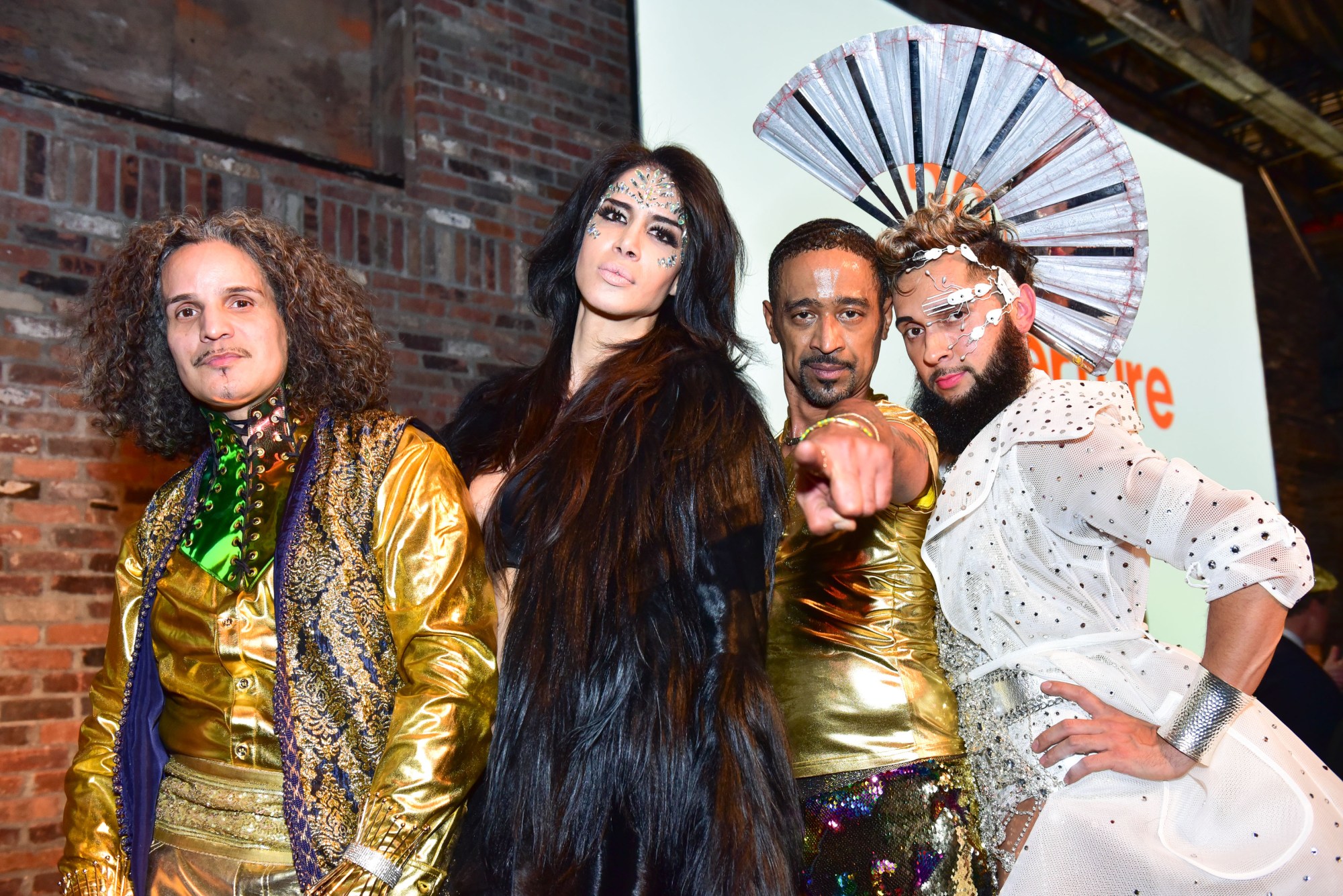With the sensual snap of his tagline, “I am still moist,” Hector Xtravaganza served it all on the runway: face, body, fashion moment, butch king, and more. However, in the wake of his death last December, it’s increasingly clear what he really served best were the generations of LGBTQ children and elders that wove in and out of New York City’s voguing and ballroom scenes. Now, on a stage flanked by his larger-than-life designs — a giant rhinestoned pump, a mirrored urn, and two monstrous gold X’s — house members, collaborators, and friends ascend to the stage and try and compress so large a life into words.
Music pumps, prayers are offered, pictures flash by, tears are shed, garments are worked, and tea is spilled. “No one would have loved this gathering for Hector more than Hector,” says Father Jose Xtravaganza. A lot of the outfits are grand (furs, feathers, evening gowns, statement hats) and sparkling (rhinestones are everywhere, sequins are more than appropriate for the occasion), and so are the feelings. The MC, G Xtravaganza, changes no less than four times, each time adding more ruffles, more rhinestones, more shining fringe, and more elements of “burnt orange,” Hector’s final signature color.
On Saturday afternoon, his extended family gathered in the theater of El Museo del Barrio in upper Manhattan to celebrate the ambassador, pioneer, designer, dancer, advocate, and grandfather. They toasted his life, reflected on his legacy, and turned a look. Two house members greet each other in floor-length frocks and assuage each other’s fears of being “underdressed.” It was a fittingly fashionable and sincerely emotional tribute to a life that had seen ball culture go from an underground haven for queer youth of color to primetime TV entertainment.
Hector (born Hector Crespo) started life in Puerto Rico, but was raised in New Jersey. In 1982, he helped found the first all Latinx voguing house, originally dubbed House of Extravaganza (the E was eventually dropped). At the time, it was a largely Black scene that originated around Harlem, New York, where the first voguing competitions were held in churches, basements, and any other space that would have them. Just beyond Stonewall and still not entirely intersectional, the house was a space of beauty for outsiders among outsiders — gay, poor, and of color. Father Jose Xtravaganza compares those early years to a battle. “We had to fight for everything, including respect in the ballroom scene and the world. We even had to sometimes fight for our lives.”
The moment would prove a momentous crossing of both good and bad fortunes for the nightlife world of New York. While a growing number of mega-clubs like XL, Tracks, and Red Zone were finally bringing supermodels and tastemakers downtown, the AIDS epidemic began to ruthlessly decimate a generation. Against this background, the houses (later made famous by Jennie Livingston’s 1990 documentary, Paris Is Burning) emerged as “chosen family” for their members. As his blood cousin and collaborator, Jose Disla Hector remembers Hector putting it, “blood does not family make, that’s relatives.”
In an era where the Reagan administration considered racism and homophobia something of a joke, these self-created, tight-knit webs gave vulnerable gay and trans youth a safety net in a world that seemed determined to push them through the cracks. As one house member recalled it at the memorial, “Those who didn’t have never went without that was Xtravaganza.” Hector continued to foster, encourage, financially support, and (when necessary) read generations to come until his passing at the age of 53.
Photographer and activist Luna Luis Ortiz describes with laughter through tears, the nicknames Hector would assign to people. He had declared Ortiz his “freedom child” and not just because of his outgoing spirit, but because of Ortiz’ willingness to disclose his HIV status in the years that it could cost him everything. It was a move that was brave, but also critical for educating and uplifting his younger LGBTQ family members. As Ortiz puts it, “[Hector] would plant a seed” in his kids, so that they could grow.
Although his life was cut short, he did live long enough to watch those seeds blossom in unexpected ways – from the mainstreaming of voguing through collaborations with artists like Madonna to his consulting and performing work on the FX show Pose. Ortiz notes with a certain bittersweet wit that Hector did not live to see Billy Porter’s homage to one of his signature looks on this year’s Oscar’s red carpet, which was just as well, because Ortiz believes he would’ve clapped back with a fierce “I wore it better” or “she don’t ever!”
His contribution to the show may be the best-known of his contributions to ballroom culture, but according to its star and his longtime friend Dominique Jackson, it was not the greatest of his accomplishments. Based on her own experience, this world is a vastly better place because of Hector’s unique ability “to take so many in and love them all individually.” Adding that he was “an advocate for everyone” in his understanding of what it is to be an outsider in this world and the importance of finding and creating chosen family. “If not for ballroom culture,” she tearfully recalls him saying. “How many more would we have lost?”
